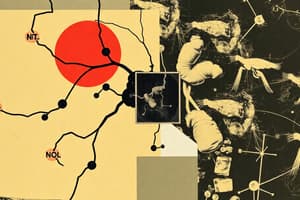Podcast
Questions and Answers
What is the primary function of cholinergic drugs in the body?
What is the primary function of cholinergic drugs in the body?
- They enhance muscle contraction directly.
- They mimic the action of acetylcholine. (correct)
- They mimic the action of norepinephrine.
- They block cholinergic receptors.
Which type of cholinergic drug directly mimics the action of acetylcholine?
Which type of cholinergic drug directly mimics the action of acetylcholine?
- Direct-acting agonists (correct)
- Indirect-acting agonists
- Cholinesterase inhibitors
- Anticholinergic agents
Which drug is commonly used to treat anticholinergic toxicity?
Which drug is commonly used to treat anticholinergic toxicity?
- Bethanechol
- Neostigmine
- Donepezil
- Physostigmine (correct)
What condition can bethanechol help treat effectively?
What condition can bethanechol help treat effectively?
Which side effect is commonly associated with cholinergic drug use?
Which side effect is commonly associated with cholinergic drug use?
What severe symptom may occur due to cholinergic drug toxicity?
What severe symptom may occur due to cholinergic drug toxicity?
Which of the following conditions is a contraindication for using cholinergic drugs?
Which of the following conditions is a contraindication for using cholinergic drugs?
Which medication is used to improve cognition in Alzheimer's disease?
Which medication is used to improve cognition in Alzheimer's disease?
What is the action of indirect-acting cholinergic agonists?
What is the action of indirect-acting cholinergic agonists?
What adverse effect may necessitate monitoring in patients prescribed cholinesterase inhibitors?
What adverse effect may necessitate monitoring in patients prescribed cholinesterase inhibitors?
Flashcards are hidden until you start studying
Study Notes
Overview of Cholinergic Drugs
- Definition: Cholinergic drugs are compounds that mimic the action of the neurotransmitter acetylcholine (ACh) in the body.
- Mechanism of Action: They act on cholinergic receptors (muscarinic and nicotinic), influencing various physiological functions.
Types of Cholinergic Drugs
-
Direct-Acting Cholinergic Agonists
- Mimic the action of acetylcholine.
- Examples:
- Bethanechol: Increases bladder contraction.
- Pilocarpine: Treats glaucoma and dry mouth.
-
Indirect-Acting Cholinergic Agonists (Cholinesterase Inhibitors)
- Inhibit the enzyme acetylcholinesterase, increasing ACh levels.
- Examples:
- Neostigmine: Reverses muscle relaxation in myasthenia gravis.
- Physostigmine: Treats anticholinergic toxicity.
- Donepezil: Used in Alzheimer's disease to improve cognition.
Clinical Uses
- Glaucoma: Reduces intraocular pressure (e.g., pilocarpine).
- Myasthenia Gravis: Improves muscle strength (e.g., neostigmine).
- Postoperative Urinary Retention: Stimulates bladder contraction (e.g., bethanechol).
- Alzheimer’s Disease: Enhances cognition (e.g., donepezil).
- Antidote for Anticholinergic Overdose: Physostigmine used as a treatment.
Side Effects
- Common Side Effects:
- Nausea
- Diarrhea
- Increased salivation
- Sweating
- Abdominal cramps
- Severe Toxicity:
- Possible with overdose or poisoning (e.g., organophosphates).
- Symptoms include muscle twitching, respiratory distress, and convulsions.
Contraindications
- Asthma: May bronchoconstrict.
- Cardiac Issues: Can cause bradycardia.
- Peptic Ulcer Disease: Increased gastric secretion may worsen symptoms.
- Urinary Tract Obstruction: Can exacerbate blockage.
Important Considerations
- Monitor for signs of toxicity, especially in patients on cholinesterase inhibitors.
- Dosing adjustments may be needed based on individual response and side effects.
- Assessment of baseline and ongoing symptoms is essential for effective treatment.
Overview of Cholinergic Drugs
- Cholinergic drugs replicate the effects of acetylcholine (ACh), a key neurotransmitter in the body.
- Function through interaction with cholinergic receptors, specifically muscarinic and nicotinic types.
Types of Cholinergic Drugs
-
Direct-Acting Cholinergic Agonists: Act like acetylcholine.
- Bethanechol: Promotes bladder contraction, useful for urinary retention.
- Pilocarpine: Treats glaucoma by lowering intraocular pressure and alleviates dry mouth.
-
Indirect-Acting Cholinergic Agonists (Cholinesterase Inhibitors): Prevent breakdown of acetylcholine, increasing its levels in the body.
- Neostigmine: Effective in reversing neuro-muscular block in myasthenia gravis.
- Physostigmine: Used to counteract anticholinergic drug toxicity.
- Donepezil: Improves cognitive function in Alzheimer’s disease.
Clinical Uses
- Glaucoma management with agents like pilocarpine to lower intraocular pressure.
- Treatment of myasthenia gravis to enhance muscle strength using neostigmine.
- Addressing postoperative urinary retention with bethanechol to stimulate bladder activity.
- Cognitive enhancement in Alzheimer’s patients via donepezil.
- Anticholinergic overdose management with physostigmine.
Side Effects
- Common adverse reactions include nausea, diarrhea, increased salivation, sweating, and abdominal cramps.
- Severe toxicity may arise from overdose or exposure to organophosphates, leading to muscle twitching, respiratory distress, and seizures.
Contraindications
- Asthma patients may experience bronchoconstriction.
- Cardiac patients risk bradycardia from cholinergic stimulation.
- Peptic ulcer disease may worsen due to increased gastric secretions.
- Urinary tract obstruction can be aggravated by these drugs.
Important Considerations
- Regular monitoring for toxicity signs, particularly in those on cholinesterase inhibitors.
- Dosing adjustments may be necessary to tailor treatment based on patient response and side effects.
- Continuous assessment of baseline and current symptoms is crucial for effective therapy.
Studying That Suits You
Use AI to generate personalized quizzes and flashcards to suit your learning preferences.




